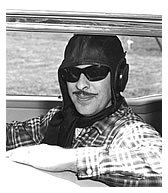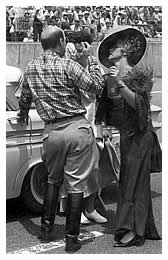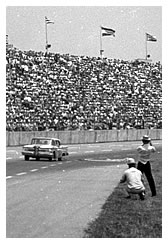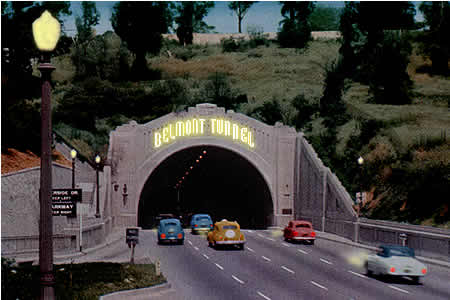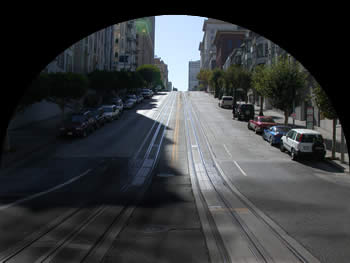Whimsy | Belmont Tunnel: The Untold Story
It was in the early days of World War II, when Irving Glick was hiding out from the draft board in the barren, glacier-scarred lands of western Colorado, that he stumbled across a feature in the landscape, which--as unremarkable as it was--would change his life forever. In the side of a nondescript mountain was an old abandoned mine shaft that fascinated him. Time after time, he would visit this hole in the hill, exploring its mysteries, and then one fateful day he discovered that the far end of the mine opened up at the other side of the mountain, onto a beautiful, peaceful valley. It was not a mine at all, it was a tunnel!
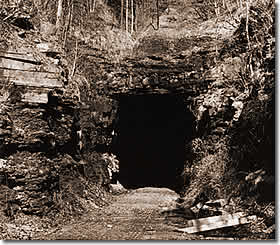 |
Irving's tunnel in Colorado |
Rushing back to the ramshackle cabin, he found Gertrude, his wife, at her usual place, sitting on a sycamore stump beside their sagging back stoop. The pigs that normally snuffled around her feet for table scraps were absent this day, putting her in a more dejected mood than usual. She lowered her ragged bodice and proceeded to suckle their infant daughter, Consuela, as Irving excitedly told her of his find, and of his vision: the tunnel (he was already calling it a tunnel) would be the key to their future. It would bring them riches and fame. It would enable them to leave this God-forsaken hellscape and go back to where dry heat would not parch a man's throat; where thin mountain air would not starve and wither his lungs; where grass and crops would grow; where winter winds were not like unceasing, howling hounds of hell and in the winter time a man's house was not buried under 20-foot-deep drifts of snow; where it would rain every once in a while, for chrissake. For the first time in a long while, he managed to elicit from Gertrude a tentative smile. "Good Lord," she whispered with a phlegmy chuckle, displaying her remaining tooth, "We be goin' back to North Carolina."
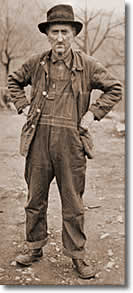 |
Fern B. Phelps |
Aside from an occasional visit to his underground obsession, Irving spent the next several months in an alcoholic stupor in the dives and stables of Devil's Ditch, Brimstone County's only town, making a pest of himself to the other barflies, incoherently rambling on about his tunnel. And then one morning someone rushed through the swinging doors of Irving's saloon du jour and excitedly announced it was V-J Day; the war was finally over! Irving sat quietly letting the news sink in. He could go home again, home to Belmont and Mama. He arose, straightened his filthy clothing, brushed the dirt and dried vomit flecks off his lapels, struggled to gather his faculties, and without a word staggered smartly out of the saloon never to return. He was going home, and he was going to take the tunnel with him!
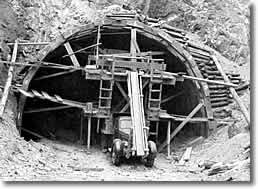 |
Shoring up the tunnel for transport |
He couldn't do it alone, of course. And early on, as fate would have it, a stranger walked up into the Glicks' yard, causing the chickens to scatter every which way. He was a tall man, in clean overalls, whose stern but gentle visage projected a quiet resoluteness, a compassion, an inner strength and, not least of all, a steel-hard core of trust and loyalty. His name was Fern B. Phelps. Gertrude peeped out through the punched-out screen door and uttered the query so commonly used by people of her station, "Whut?" Fern removed his hat, introduced himself, recited some of his qualifications, and then asked the question that would begin the next, and most remarkable, phase of their lives. Through the mesh, Fern's confident, unrelenting gaze drilled into Gertrude's hazel eyes, and he asked, "Y'all got any tunnels you want moved?"
The next year was to be a tumultuous time, a flurry of planning and preparation, of moving vast quantities of earth, of designing, building and installing an unprecedented array of wood and metal bracing, of shearing away the outer mass of an entire mesa, so that the tunnel could be packed and safely shipped by train to Carolina. |
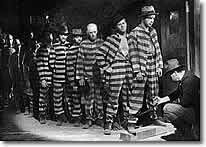 |
Fern's trusted and loyal crew |
Although a simple man, Fern was not without resources and influence. His brother was an official at the Colorado State Prison in Cañon City, who provided him a crew of willing and enthusiastic workers. Also, Fern's nephew had an important job at the Denver & Rio Grande Railroad, and welcomed the challenge of building a flatcar nearly a mile long so that the tunnel could be transported in one piece across the continent.
On December 12, 1946, the "tunnel train" arrived at the Charlotte depot. No newspaper reporters or photographers were present to record the event (it was after 5:00), but the story has been passed down across the generations how the mayors of both Belmont and Charlotte, representing the massed throng, welcomed the Glicks and Phelps and his crew of temporarily-paroled "tunnel rats," and the railroad men who had driven the longest, strangest train anyone in these parts would ever see.
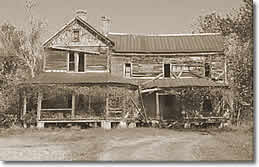 |
The tunnel was stored behind Valvaleen Glick's house |
Of course, in order to install a tunnel, you must have a hole to put it in, so the next two years were spent drilling under the Catawba River between Charlotte and Belmont. A large contingent of "sand hogs" was brought down from New York City, many of whom had helped build the great Lincoln and Hudson Tunnels. While the Catawba preparation was underway, the tunnel itself was temporarily coiled up in a field behind the old Glick home place. Irving's mama, Valvaleen, spent a long two years, constantly annoyed by the mobs of people that would come from miles around to drive through the above-ground tunnel, mostly at night. They would honk their horns in delight after finding out that they came out not 10 yards from the spot they went in. |
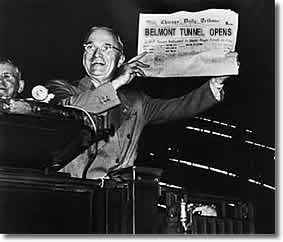 |
Pres. Truman celebrates tunnel opening |
And then, at long last, the grand opening, a huge event. President Truman addressed congress and sent a special telegraphed message to be read to the large crowds gathered around each end of the new, the magnificent, Belmont Tunnel.
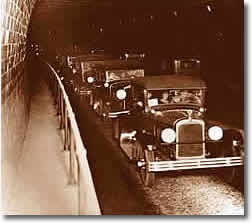 |
Plaza-Midwood Old Car Club |
Members of the Midwood-Plaza Old Car Club formed a parade of their spruced-up Fords and drove through. Flashbulbs popped. Every other person seemed to be a newspaper reporter, wearing a fedora with a "press" card stuck in the band. WBT did a nemo (remote broadcast) and Grady Cole said a few kind words about the Glicks and their accomplishment, and introduced three-year-old Consuela. Gov. Kerr Scott delivered a long speech, then the Johnson Family sang "The Tunnel Song," written especially for the occasion by Larry Walker. If you've forgotten, it began, "The tunnel song, the tunnel song, everybody's singing the tunnel song." Arthur Smith later claimed the lyrics were his. The lawsuit is still pending. |
Of course all the national papers headlined the news. The New York Herald News Sun Journal American Globe Tribune said the feat was comparable to the Lewis & Clark Expedition, the Panama Canal and the executions of Sacco and Vanzetti. Theater-goers around the world saw newsreel stories of the tunnel narrated with urgency by the booming voices of Lowell Thomas and Ed Herlihy.
Inside The Tunnel
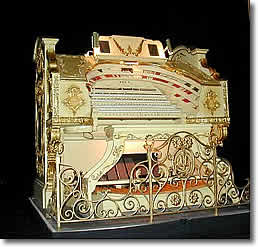 |
The famous tunnel organ |
In an area off to the right (as you entered the Charlotte side) there was a special candle-lit room containing an ornate pipe organ on which, as the years went by, various artists (renowned and otherwise) would perform. Built by Bavarians in the 1920s, the organ was "appropriated" by Luftwaffe chief Hermann Goering and was often used to entertain Adolph Hitler. In fact, stored under the lid of the organ seat was the sheet music to Deutschland, Deutschland, über alles, although Irving, being extremely patriotic, never allowed the hated anthem to be played in the tunnel.
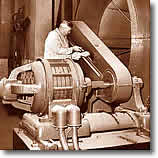 |
Turbine and engineer |
The organ, a musical marvel, was incredibly expensive to maintain. Powered by a huge turbine, it required three maintenance engineers. The turbine itself was propelled by the rushing water of the Catawba above the tunnel, and was housed in a complex deep below, where there were living quarters for the engineers' families. The engineers also maintained the snorkle-like "takeout" tubes that ran up from the tunnel's roadsides through the murky water to just above the river's surface. Waiters from the Pirate's Cove Fish Camp would row out and drop fried perch and hushpuppies into the tubes to hungry motorists double parked below. |
Later years
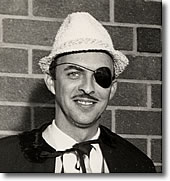 |
The increasingly eccentric (yet exceedingly handsome) Irving Glick (1964) |
Irving served for many years as the president of the Belmont Tunnel Authority. An entrepreneur always seeking the advantage, he was uncannily quick to show up wherever there was money to be made, involving himself in deals both shady and shaky.
 |
The consistently dapper Bill Curry (1964) |
Some believe that because WBT's Bill Curry owed Irving an enormous gambling debt, with no likelihood of ever paying it off, Irving blackmailed Curry into broadcasting various tunnel activities. When asked about it, Curry would utter the query so commonly used by people of his station, "Whut?"
There has been some speculation that it was not the gambling debt that got Irving and his tunnel featured prominently and often on the radio, but rather Curry's torrid clandestine affair with Consuela, Irving's beloved daughter (named after her great grandmother, who was a camp follower of the Portuguese army).
To round out the story, Gertrude passed away some years ago, willing her tooth to the Gaston County Collectibles Museum. Consuela lives in coastal South Carolina alongside a swampy, snake-ridden black water creek and draws welfare. Fern Phelps and his band of convicts returned to Colorado in 1949 and lost all contact with the Glicks. Bill Curry is retired and surfs the Internet. The majestic organ, which entertained so many over WBT, was sent back to its rightful owners in Bavaria.
The old tunnel, rendered obsolete by the new bridges and highways of later years, has been out of favor for several decades, well off the beaten path. Every so often some curious historian or reporter will happen by, pull back the weeds and vines that now obstruct the entrances, shudder, and wonder what all the fuss was about.
As for Irving Glick, the man of vision, he is confined to a home for the acutely egocentric in the shadow of Crowder's Mountain, and rarely has visitors.
— RB |
